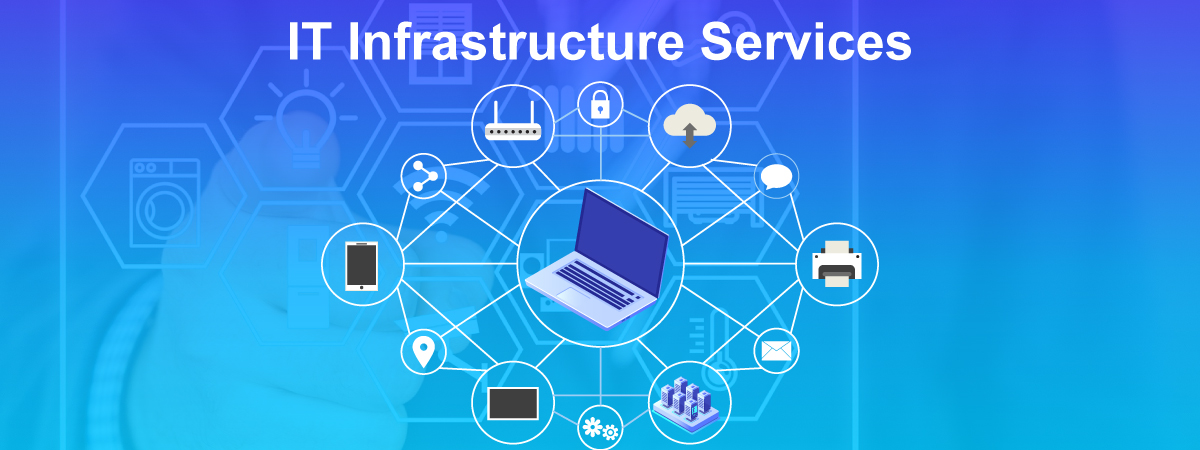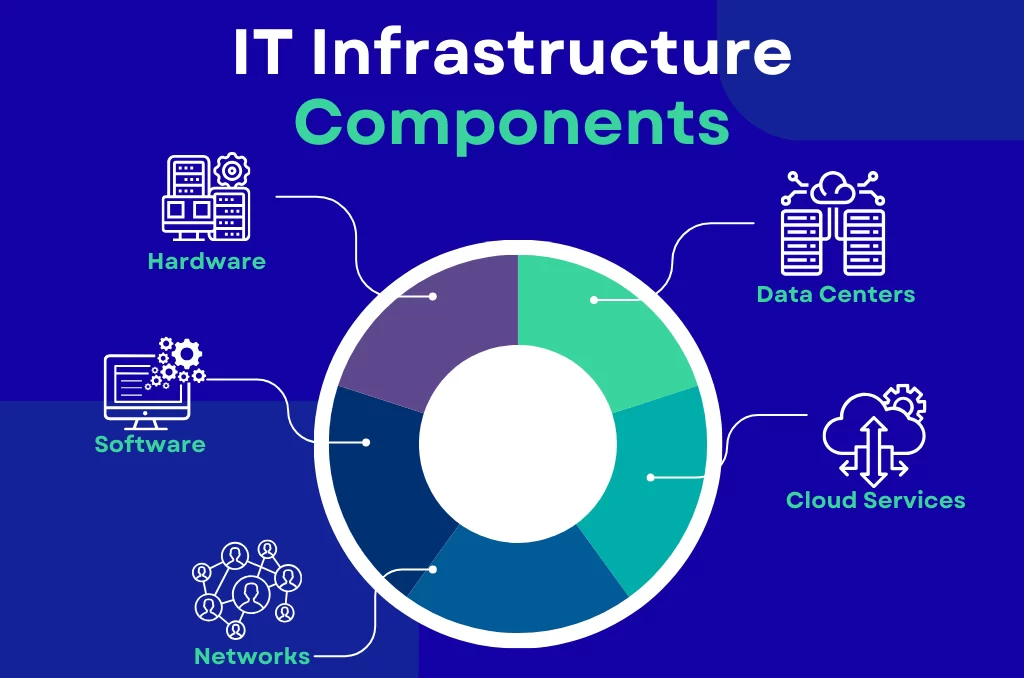Introduction: IT Infrastructure Isn’t Just Tech — It’s a Strategic Advantage
In today’s hyper-connected world, your IT infrastructure can make or break your business. Whether you’re a startup in Toronto, a law firm in Dallas, or a growing e-commerce brand in London, the quality of your IT foundation directly impacts your performance, productivity, scalability, and security.
Fact: 42% of SMBs experience costly downtime every year due to outdated or under-optimized IT environments.
Stat: Businesses with modern, well-optimized infrastructure are 3X more likely to meet growth goals.
In this blog, we’ll explore the 7 key advantages of a well-optimized IT infrastructure — and how investing in the right tech setup today sets the stage for tomorrow’s success.

Increased Productivity Across Teams
A slow network, outdated hardware, or unreliable connectivity isn’t just annoying — it’s expensive.
Use Case: A construction firm in Calgary upgraded their network and replaced legacy servers with a cloud-based setup. As a result, internal communication speeds improved by 60%, and team collaboration became seamless.
Benefits:
- Faster systems = less downtime
- Optimized tools = better collaboration
- Modern infrastructure supports remote & hybrid work
Tip:
Implement tools like Microsoft 365, SharePoint, and cloud storage with managed patching to minimize disruption.
Improved Data Security & Threat Protection
Cyber threats are growing more advanced — and SMBs are now top targets. A weak IT infrastructure leaves gaps in your defense.
Fact: 60% of small businesses close within 6 months of a cyberattack.
Key Security Advantages of Optimized Infrastructure:
- Updated firewalls & threat detection systems
- Encrypted backups and secure access protocols
- Segmented networks to prevent lateral breaches
- Managed antivirus and endpoint protection
Real-World Example: A legal firm in Vancouver migrated to a secure cloud server with managed endpoint protection. In a simulated phishing test, attempted data theft was blocked — saving them a potential $25,000 breach cost.

Better Scalability & Flexibility
As your business grows, your infrastructure must scale with it — not hold you back.
Benefits of Scalable IT Infrastructure:
- Easily add new users, offices, or devices
- Expand storage, bandwidth, and processing power on demand
- Support more apps and integrations without lag
- Switch from CapEx (hardware) to OpEx (cloud subscriptions)
Use Case: A digital marketing agency expanded from 5 to 25 employees. Thanks to cloud-based infrastructure and a virtual desktop environment, onboarding new hires took minutes — not days.
Pro Tip:
Use hybrid cloud environments to balance cost, performance, and security based on workloads.
Read More : Cloud Security Practices for a Smooth Migration
Lower IT Costs & Predictable Budgeting
While investing in optimization may seem costly upfront, it often leads to significant long-term savings.
Ways Optimized Infrastructure Saves Money:
| Cost Area | How Optimization Helps |
| Downtime | Reduced by 70–90% |
| Maintenance | Managed services reduce internal staffing needs |
| Hardware lifecycle | Cloud reduces capex needs |
| Energy bills | Efficient systems use less power |
| Licensing | Consolidated platforms save money (e.g., Microsoft 365) |
Tip: Use a managed IT provider to convert large upfront costs into predictable monthly subscriptions.

Enhanced Customer Experience
Your internal tech setup directly impacts your customer-facing performance. Whether it’s fast load times, real-time chat, or secure portals — infrastructure matters.
Examples:
- Faster servers = faster websites
- Stable networks = smoother VoIP customer service
- Secure systems = increased customer trust
- Automation = faster responses and support
Real-World Story: An online retailer in Texas revamped their backend and added load-balanced servers. Their website’s bounce rate dropped by 21% after improving load speed by 2 seconds.
Read More : The Role of AI in Web Design
Business Continuity & Disaster Recovery Readiness
IT downtime isn’t just frustrating — it can be fatal. A well-optimized IT environment includes backup strategies, failover systems, and disaster recovery plans to ensure you’re not caught off guard.
Must-Have Features:
- Automated cloud backups
- Multi-site or hybrid storage
- DR drills and testing
- SLA-backed recovery times
Fact: The average cost of downtime is $5,600 per minute for SMBs.
Use Case: After a ransomware attack, a manufacturing company in Montreal restored full operations in under 2 hours — thanks to real-time backups and cloud failover systems managed by GoGeekz.

Competitive Advantage in the Marketplace
An optimized IT infrastructure isn’t just an internal improvement — it’s a strategic asset.
How It Gives You the Edge:
- Faster response times = happier customers
- Real-time analytics = smarter decisions
- Future-readiness = faster adoption of new tools
- Compliance = credibility in regulated industries
Example: A healthcare clinic met new HIPAA and PIPEDA standards by upgrading their server environment and enabling secure communications. They used it as a selling point in their marketing — and earned 3 new contracts.
Common Mistakes Businesses Make With IT Infrastructure
| Mistake | Risk |
| Delaying upgrades | Outdated systems are insecure and inefficient |
| No disaster recovery plan | High risk of extended downtime |
| DIY IT support | Limited skills = poor fixes = higher costs later |
| One-size-fits-all tools | Poor user experience and wasted money |
Metrics to Monitor in an Optimized IT Environment
| Metric | Why It Matters |
| Network uptime | Measure of availability |
| Average resolution time | IT support efficiency |
| Backup success rate | Data recovery reliability |
| System resource usage | Forecast capacity needs |
| User satisfaction scores | End-user experience |
Myths vs. Facts
| Myth | Fact |
| “We’re too small to need infrastructure upgrades.” | SMBs are the most vulnerable to threats and inefficiencies. |
| “Cloud isn’t secure.” | Leading cloud platforms have stronger security than most on-prem setups. |
| “Upgrading is too expensive.” | Long-term cost savings and productivity gains outweigh initial spend. |
| “We already have antivirus, that’s enough.” | Antivirus is one part of a modern, layered IT security strategy. |
Conclusion
A well-optimized IT infrastructure isn’t a luxury — it’s a strategic necessity for any business aiming to grow, compete, and thrive in 2025 and beyond.
It impacts everything from employee productivity and cost control to cybersecurity and customer satisfaction. Whether you’re scaling, upgrading, or just trying to prevent the next outage, now is the time to invest in your digital backbone.
At GoGeekz, we help SMBs:
- Audit and optimize their current infrastructure
- Migrate to secure cloud or hybrid environments
- Protect against downtime, ransomware, and data loss
- Build tech foundations that support long-term growth
Want to evaluate and upgrade your IT infrastructure?
Book a FREE Infrastructure Health Check with GoGeekz Now
FAQs
Industry Experiences
Innovative services for your business
We’re dedicated to making your businesses reliable, efficient, and safe.
We’re a one-stop solution for everything IT you need. Whatever you need, we got you covered:
At least once a year — or during major growth, migrations, or compliance changes.
Yes! Many businesses start with network optimization, then move to cloud, DR, and compliance.
A hybrid model often works best, especially if you have compliance or latency concerns.
Frequent downtime, frustrated employees, slow systems, and poor customer reviews are all red flags.




